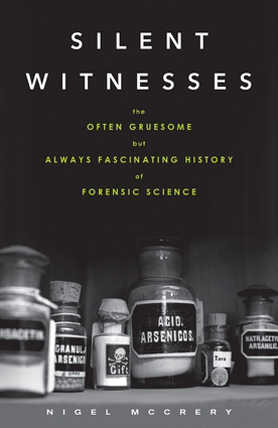You saw everything go down.
There was a brief fight before the woman shoved the man into the side of the car. That surprised you, but not as much as when she pulled out a small gun and shot him once, twice. He fell, she ran, and then there were sirens.
The TV camera showed you everything, but what about real life? Crime scene experts don’t have benefit of scripts; they have to have certain knowledge to solve a crime. And in “Silent Witnesses” by Nigel McCrery, you’ll read about how it all began.
Imagine being arrested for a crime you didn’t commit.
You would, of course, hope that DNA testing, ballistics, blood spatter tests, and myriad other scientific knowledge would exonerate you, fast. So now, imagine that none of that has yet been invented.
The first man to attempt to create a way to identify victims and criminals was Alponse Bertillon. In the mid-1800s, he devised a method of assembling cut-up pictures, puzzle-style, until officials could get a better idea of who to apprehend. It wasn’t perfect, by far, but we still use that method today, albeit one that’s refined.
Ancient Babylonians knew about fingerprints, but only in the late 1700s did someone notice that no two prints were alike. It took awhile – a hundred years – before someone realized that that information could be used for crime-solving.
Back when guns were first invented, they were quite expensive, therefore, rare and used mainly by the rich. For this reason, criminals weren’t initially quick to use them but, because of war, guns were cheap and plentiful in Europe by the sixteenth century. Still, it wasn’t until well into the 1700s that a murder was solved by forensic ballistics, and the late 1800s before chemical bullet analysis was used to find a killer.
Amazingly, it wasn’t until the early 1900s that forensics experts could tell human blood from animal blood. Poison has been around centuries, but detection of such has only been available some 250 years. Microscopes were used as early as the late Middle Ages, but they came slowly to crime detection. And as for identifying a body, well, let’s just say that early scientists couldn’t “afford to be squeamish.”
I was rather less than impressed by “Silent Witnesses” at first.
Author Nigel McCrery begins with a crime solved by revolutionary, modern methods – then he plunges readers into a deadly-dull account of the methods of identity of yore. Yes, this is a history book, I know, but I felt somehow let down. I wanted something livelier with my murder-and-mayhem.
Fortunately, that comes about 50 pages in, so patience is a virtue here. Once you’re that far, McCrery’s history becomes less sensational and more like the gritty stuff that keeps CSI fans riveted. At that point, it’s much easier to enjoy this book.
Keep in mind that big-time true-crime fans might not find much new, but this book could still be worthwhile. If you really love this kind of reading, “Silent Witnesses” may be impossible to put down.
The Bookworm is Terri Schlichenmeyer. Email her at bookwormsez@gmail.com.

